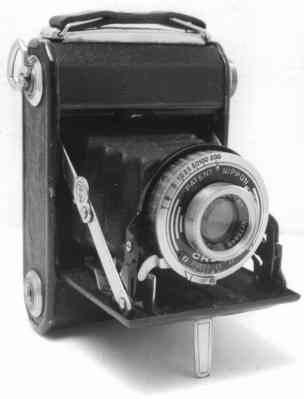
MINOLTA FOLDING CAMERAS

This list is inaccurate and incomplete. If you are able to provide more accurate information than is listed here, please contact us.

(1929) 75mm lens. Shutter speeds of T, B, 1/25 - 1/100 (varies). At least two models were built, but there were changes made within each of these models, such as shutters (and speeds) and lenses (and maximum apertures). So it all depends on how you define a "model". Thay all used the same 127 film and produced 4x6.5 images. Often seen listed as Nifcalette.

(1930) 65mm (f4.5) lens. Shutter speeds of T, B, 1 - 1/250. Used sheet film or plates. The had shift and tilt features built in. 6x9 images.
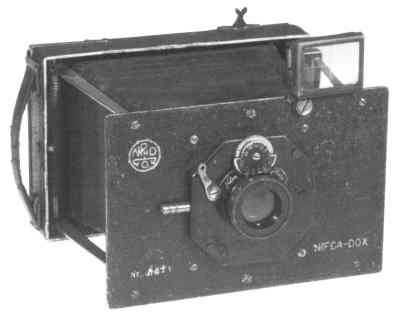
(1930) 105mm (f6.8) lens. Shutter speeds of T, B, 1/25 - 1/100. Used sheet film or plates.
(1930) 105mm (f6.3) lens. Shutter speeds of T, B, 1/25 - 1/100. Used sheet film or plates.
(1931) 105mm (f4.5) lens. Shutter speeds of T, B, 1 - 1/200. Used sheet film or plates.
(1931) 105mm (f6.3) lens. Shutter speeds of T, B, 1/25 - 1/100. Used sheet film or plates.
(1931) 105mm (f4.5) lens. Shutter speeds of T, B, 1/5 - 1/200. Used sheet film or plates.
(1931) 105mm (f4.5) lens. Shutter speeds of T, B, 1/25 - 1/100. Used sheet film or plates in a folding box style.
(1933) This was the first Plaubel-type side-strut folding camera made in Japan. 105mm (f4.5) Actiplan Anastigmat 105mm f4.5 made by Asahi. Crown shutter with speeds of T, B, 1 - 1/200. Built-in rangefinder. Used sheet film or plates for 6.5cm x 9cm images.
(1934) An improved version of the Minolta. This model used an improved three-strut system for extra rigidity. And the shutter was fitted with a safety switch to prevent accidental exposures. It had the same 105mm (f4.5) lens made by Asahi. Crown shutter with speeds of T, B, 1 - 1/200. Built-in rangefinder. Used sheet film or plates for 6.5cm x 9cm images.
(1934) An improved version of the Minolta Auto. It had the same 105mm (f4.5) lens made by Asahi. Shutter speeds of T, B, 1 - 1/200, but some models have been seen with a 1 - 1/250 Compur shutter from F.Deckel-Munchen. Built-in rangefinder. Used sheet film or plates for 6.5cm x 9cm images.
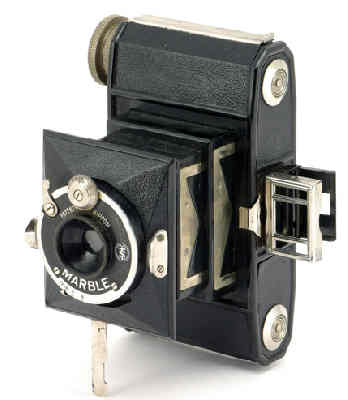
(1934) Up to this point, folding cameras always used leather bellows. Minolta was the first -- with this camera -- to use a system of decreasing size, "plastic" (bakelite) sections that collapsed into each other. Six models were built. All had a 75mm lens, but this saw some changes over time. The earliest model was the f8.0 lens which was fixed-focus, but a close-up lens was sold as an accessory. Maybe a year later, Minolta added an f5.6 model which was sold along with the f8.0 model. And finally Minolta added a focusing f5.6 version to the line-up. All had shutter speeds of T, B, 1/25 - 1/100 and f-stops to f22.0. They both use 127 film and can produce either 4x6cm or 3x4cm images with an insertable mask. Pop-up viewfinder. Bakelite body. This camera was also sold as the Minolta Vest (the most commonly seen name -- and that ain't too often!), and is also called the Minolta Marble because of the "MARBLE" name of the shutter prominently displayed on the front..Production was probably ended due to the war. Japan was at war with Korea and China long before Britain and France declared war on Germany.
See the Minolta Best.
See the Minolta Best.

(1934) This was the first Japanese camera to use the 6x4.5cm format. In fact, that's where the term "Semi" comes from. It means that only part of the normal 6x9 format is used. The "Semi" label was not just used by Minolta. Olympus, Petri, Konica, Leotax, and other manufacturers made cameras that were labeled "Semi", as well. But the Minolta Semi was different. While it was not the first 6x4.5cm format camera, it was the first 6x4.5cm format camera to be fitted with an accessory shoe. The 75mm (f4.5) Corona Anastigmat lens was made by Asahi -- like a lot of Minolta's lenses in those days. Two models were built with shutter speeds of B, 1/5 - 1/100 or shutter speeds of B, 1/5 - 1/200. Needless to say, it used 120 film.

(1935) This camera used a plastic sectional bellows like the Minolta Vest. Two models were built. Shutter either Crown leaf shutter (1/25 to 1/150 plus T, B) or shutter speeds of T, B, 1/25 - 1/200. 75mm lens f4.5 or 80mm f5.6 Coronar Anastigmat Nippon. Used 120 film.

(1937) Had a coupled rangefinder and a cordless bracket for flash use. 105mm (f3.5) Promar Anastigmat 105mm f3.5 made by Asahi. Shutter speeds of T, B, 1 - 1/400. Built-in rangefinder. Interchangeable back to allow the use of sheet film, plates, film packs or 120 rollfilm.

(1937) 75mm (f4.5 or f3.5) lens. Four models were built. Shutter speeds of B, 1/5 - 1/175 or shutter speeds of B, 1/5 - 1/200. Used 120 film. At the same time, Minolta manufactuered its first clip-on rangefinder. It fit into the flash shoe of the camera and accurately determined the distance to the subject for more precise focusing and flash exposure.
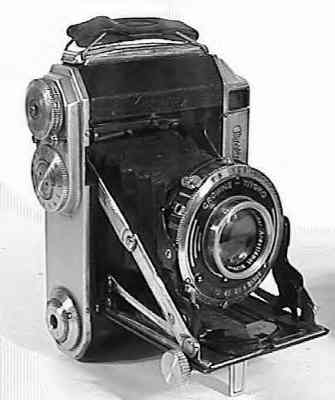
(1937) The first Japanese camera to use a rack and pinion focusing mechanism coupled to a rangefinder. An automatic stop simplified film advance. 75mm (f3.5) Promar Anastigmat 75mm f3.5 made by Asahi. Two models were built. Shutter speeds of B, 1 - 1/250 or shutter speeds of B, 1 - 1/400. Used 120 film.

(1946) This was the first Minolta camera (consumer market) with a lens that was actually made by Minolta, but it also came with Promar and Zuiko lenses. All previous camera lenses were made by other optical companies. This does not mean that later Minolta cameras did not use non-Minolta lenses (see the Auto Semi P of 1952) This was also the first Japanese lens to incorporate an anti-reflective coating. It was a 75mm (f3.5) lens. Shutter speeds of B, 1 - 1/500. Used 120 film. Variations exist. Some models have flash synch, some don't, for example.
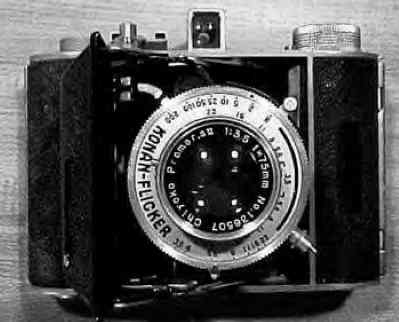
(1952) This was Minolta's last "folder" and the one you are most likely to see. The 75mm (f3.5) Promar lens was made by Asahi, but Minolta made the Konan shutter. Like the earlier versions of the Semi, it came with a viewfinder, but at the same time, Minolta updated its earlier, clip-on rangefinder. It fit into the flash shoe of the camera and accurately determined the distance to the subject for more precise focusing and flash exposure. Two models were built. Shutter speeds of B, 1/2 - 1/200. Used 120 film.
COPYRIGHT@1995-2016 by Joe McGloin
All Rights Reserved.
The material on this website is protected by US Federal copyright laws. It
cannot be copied or used in any manner without specific approval from the
owner.